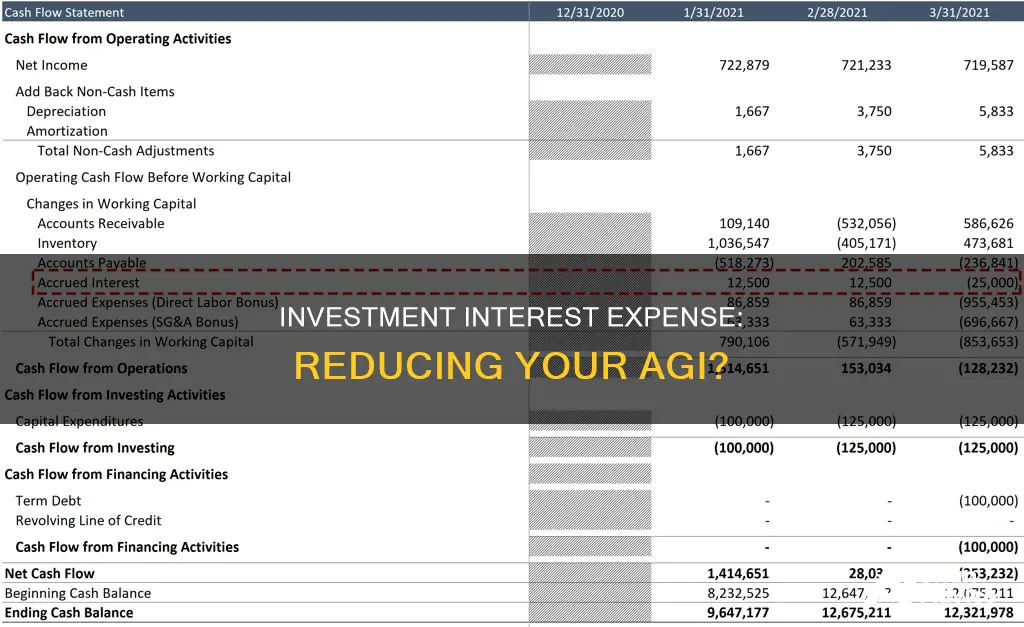
Investment interest expense can be deductible from AGI (Adjusted Gross Income) as an itemized deduction. However, there are limitations to this. For example, investment interest expense does not include interest expense that is capitalized. In addition, there are rules that taxpayers with oil and gas working interests must consider if they are subject to investment interest expense limitations.
| Characteristics | Values |
|---|---|
| Investment interest | Deductible from AGI as an itemized deduction to the extent of net investment income |
| Net investment income | Gross investment income - investment expenses |
| Gross investment income | Income from property held for investment, excluding net capital gains from the disposition of property held for investment and qualified dividend income (QDI) |
| Business interest | Deductible before AGI |
| Student loan interest | Up to $2,500 deductible before AGI |
| Oil and gas working interests | Net income or loss will impact investment income |
What You'll Learn

Investment interest is deductible from AGI as an itemized deduction
If taxpayers want to increase their investment interest deduction, they can elect to include some or all of their QDI or net capital gain in gross investment income. However, taxpayers must reduce, by the same amount, their adjusted net capital gain (i.e., QDI and net capital gain) that would be eligible for lower capital gain tax rates.
There are certain rules that taxpayers with oil and gas working interests must consider if they are subject to investment interest expense limitations. If the taxpayer does not materially participate in the working interest, the net income or loss will impact investment income. These taxpayers may benefit by taking steps that would allow them to meet the material participation standard for the activity so the net loss does not reduce their allowable investment interest expense.
Interest is classified by the way loan proceeds are used. For instance, if loan proceeds are used to buy investment property or business property, the interest paid is classified as investment interest or business interest. Up to $2,500 of interest on qualified student loans is deductible before AGI.
Savings Accounts: Lower Interest Rates than Investments?
You may want to see also

Taxpayers can deduct business interest
Investment interest is deductible from AGI as an itemized deduction to the extent of net investment income. This is calculated by subtracting investment expenses from gross investment income. Gross investment income includes interest, dividends, annuities, and royalties derived from investments, not from a trade or business.
Up to $2,500 of interest on qualified student loans is also deductible before AGI. To be considered a qualified student loan, the loan must be used for qualified education expenses, such as tuition, room, board, books, and equipment, and the student must be enrolled at least half-time in a degree or recognised educational credential program at an accredited college or university.
Taxpayers with oil and gas working interests may also be subject to investment interest expense limitations. If they do not materially participate in the working interest, they must reduce their net investment income by the net loss.
Interest Rates and Foreign Investment: A Complex Relationship
You may want to see also

Expenses subject to the 2% of AGI limitation
Investment interest is deductible from AGI as an itemized deduction to the extent of net investment income. This is calculated as follows: Gross investment income – Investment expenses = Net investment income. Investment income is the gross income from property held for investment, excluding net capital gains from the disposition of property held for investment and qualified dividend income (QDI). It includes, among other things, interest, dividends (other than qualified dividends), annuities, and royalties derived from investments, not from a trade or business.
If taxpayers want to increase their investment interest deduction, they can elect to include some or all of their QDI or net capital gain in gross investment income. However, taxpayers must reduce, by the same amount, their adjusted net capital gain (i.e., QDI and net capital gain) that would be eligible for lower capital gain tax rates.
There are other expenses that are subject to the 2% of AGI limitation. For example, if loan proceeds are used to buy investment property or business property, the interest paid is classified as investment interest or business interest. Up to $2,500 of interest on qualified student loans is deductible before AGI. To be a qualified student loan, the loan must be used for qualified education expenses, such as tuition, room, board, books, equipment, and other necessary expenses, and these expenses must be paid within a reasonable time before or after the taxpayer takes out the loan.
Additionally, taxpayers with oil and gas working interests must consider these rules if they are subject to investment interest expense limitations. If the taxpayer does not materially participate in the working interest, the net income or loss will impact investment income. These taxpayers may benefit by taking steps that would allow them to meet the material participation standard for the activity so the net loss does not reduce their allowable investment interest expense.
Mortgage Interest Rates: Higher for Investments?
You may want to see also

Taxpayers with oil and gas working interests
These taxpayers may benefit by taking steps that would allow them to meet the material participation standard for the activity so the net loss does not reduce their allowable investment interest expense. For example, if the taxpayer does not materially participate in an oil and gas working interest that generates a net loss, they must reduce their net investment income by the net loss. However, if they take steps to meet the material participation standard for the activity, they may be able to avoid reducing their net investment income by the net loss.
It is important to note that investment interest expense does not include interest expense that is capitalized. In addition, taxpayers with oil and gas working interests should be aware that investment interest is deductible from AGI as an itemized deduction to the extent of net investment income. This is calculated as follows: Gross investment income - Investment expenses = Net investment income.
Investment income includes interest, dividends (other than qualified dividends), annuities, and royalties derived from investments, not from a trade or business. Taxpayers with oil and gas working interests can increase their investment interest deduction by electing to include some or all of their qualified dividend income (QDI) or net capital gain in gross investment income. However, they must reduce their adjusted net capital gain by the same amount, which would be eligible for lower capital gain tax rates.
Lower Interest Rates: Spending and Investment Impact
You may want to see also

Up to $2,500 of interest on qualified student loans is deductible before AGI
Investment interest is deductible from AGI as an itemized deduction to the extent of net investment income. This is calculated by subtracting investment expenses from gross investment income. Gross investment income is the income from property held for investment, excluding net capital gains from the disposition of property held for investment and qualified dividend income (QDI). It includes interest, dividends (other than qualified dividends), annuities, and royalties derived from investments, not from a trade or business.
If taxpayers want to increase their investment interest deduction, they can elect to include some or all of their QDI or net capital gain in gross investment income. However, they must reduce their adjusted net capital gain by the same amount, which would otherwise be eligible for lower capital gain tax rates.
There are five types of interest expense. Taxpayers can deduct business interest, which is interest paid or accrued on indebtedness properly allocable to a trade or business (other than the trade or business of performing services as an employee). For example, a sole proprietor who borrowed money to purchase a storefront, inventory, and to meet payroll between busy seasons can deduct the interest on these loans as business interest before AGI.
Taxpayers with oil and gas working interests must consider these rules if they are subject to investment interest expense limitations. If the taxpayer does not materially participate in the working interest, the net income or loss will impact investment income.
Interest Rates: Rising Investment Opportunities and Challenges
You may want to see also
Frequently asked questions
Yes, investment interest is deductible from AGI as an itemized deduction to the extent of net investment income.
Net investment income is calculated as follows: Gross investment income - Investment expenses = Net investment income. Gross investment income is the income from property held for investment, excluding net capital gains from the disposition of property held for investment and qualified dividend income (QDI).
Investment income includes interest, dividends (other than qualified dividends), annuities, and royalties derived from investments, not from a trade or business.
Yes, taxpayers can elect to include some or all of their QDI or net capital gain in gross investment income. However, they must reduce their adjusted net capital gain by the same amount.
Yes, up to $2,500 of interest on qualified student loans is deductible before AGI. To be a qualified student loan, the loan must be used for qualified education expenses, such as tuition, room, and board, and the student must be enrolled at least half-time in an accredited program leading to a degree or other recognised educational credential.







